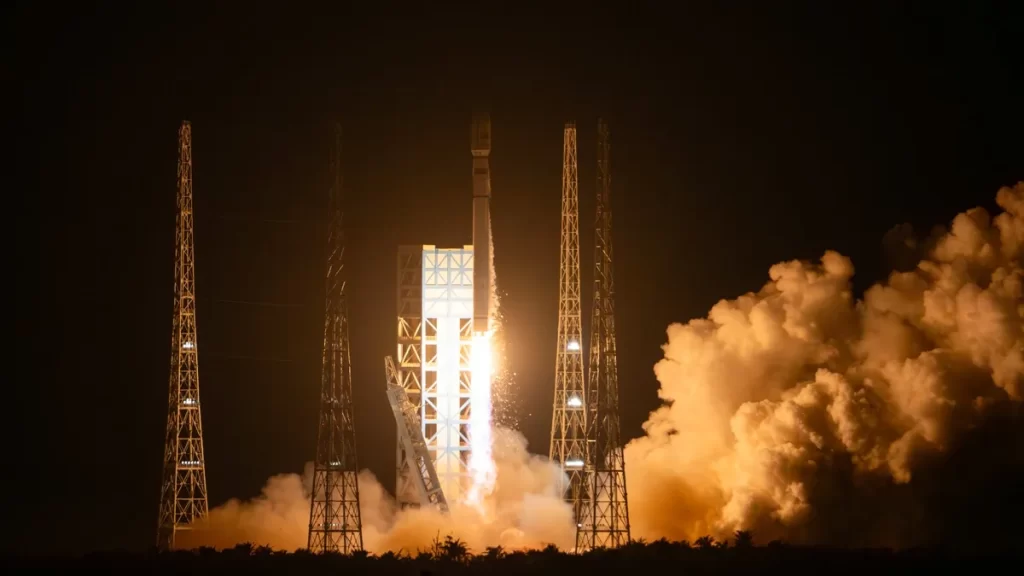Last week, China successfully debuted its new launch vehicle Long March-12, delivering two experimental satellites into orbit and marking the inaugural flight from the country’s first commercial spaceport that will support the country’s upcoming surge in commercial space activity, including deploying large satellite networks.
The 205-foot (62.6-meter) Long March-12 rocket lifted off on Nov. 30 from the Wenchang Commercial Space Launch Site in China’s Hainan Island. On board were two experimental satellites that were delivered to unspecified orbits 23 minutes post-launch, state media reported early on Dec. 1. The rocket’s maker, the state-owned Shanghai Academy of Spaceflight Technology, said the payloads were “Satellite Internet Technology Test Satellite” and “Technology Test Satellite-3” but did not provide further details, according to SpaceNews.
The two-stage Long March-12 rocket is the newest addition to the fleet of Long March launchers, the first of which debuted in April 1970 and made China only the fifth nation to achieve independent access to space. The newest rocket, which uses kerosene and liquid hydrogen fuels in contrast to toxic hypergolic propellants used by its predecessors, is capable of ferrying 10 tons to low-Earth orbit (LEO) or 6 tons to a typical sun-synchronous orbit at an altitude of 700 kilometers (430 miles).
“It is the first Chinese rocket equipped with an automatic ignition-malfunction detection system,” Xie Li, who is a senior designer of Long March-12, told the state-owned China Daily. “After the engines are ignited, the system will detect whether the engines are functioning well, and if the result is good, the system will unleash the hold-down clamps, allowing the engines to reach full power to lift off.”
The automated system is designed to perform real-time checks on the vehicle’s condition and autonomously calculate a new trajectory for mission success in case of anomalies, he added.
The Long March-12 is also the first Chinese rocket with a diameter of 12.4 feet (3.8 meters), which can accommodate four engines instead of two hosted by the rocket’s predecessors, allowing for more fuel storage and a higher payload capacity, according to Li. “Compared with other types of aluminum alloy used on older Long March-series rockets, the new material is up to 15 percent lighter in structural weight and 28 percent higher in tensile strength.”
The newly inaugurated Wenchang commercial spaceport, which is close to the country’s national spaceport (also in Wenchang) is expected to support reduced rocket fuel costs and increased payload capacities thanks to its proximity to Earth’s equator.
The spaceport’s coastal location also provides several other advantages, the most significant being the ability to more conveniently and safely transport large rockets by sea than by road to the country’s three inland spaceports. The location also allows for more efficient recovery of first stages of reusable rockets from the South China Sea, according to Chinese state media.
Chinese state-owned company HICAL, short for Hainan International Commercial Aerospace Launch Co., Ltd., has invested more than 4 billion yuan (US $553 million) to construct the launch site since it began in July 2022. The site’s first launch pad was completed last December and the second earlier this year, with each capable of supporting 16 launches a year.
In the coming years, the spaceport is expected to support several Chinese commercial space companies developing reusable launch vehicles. China also has plans for multiple commercial megaconstellations in LEO. The country has so far launched 36 of 14,000 satellites for its Qianfan or ‘Thousand Sails’ broadband network with a goal to assemble a Starlink-like megaconstellation in LEO. Similarly, the national Guowang project is expected to consist of 13,000 satellites.
Last month, Beijing-based commercial space firm CAS Space launched its first satellite for an international customer, the Sultanate of Oman, signaling a broader strategy to expand internationally despite challenges posed by export regulations due to geopolitical tensions between the U.S. and China and competition from SpaceX.
Source: https://www.space.com/space-exploration/launches-spacecraft/china-debuts-usd553-million-spaceport-with-launch-of-new-long-march-12-rocket-video



